Fantasy Books
What a Croc, Part II
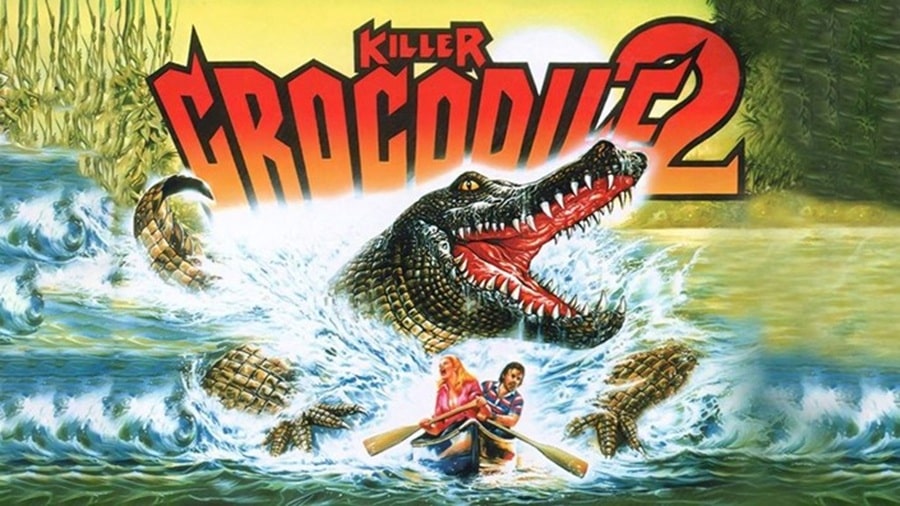 Killer Crocodile 2 (Fulvia Film, 1990)
Killer Crocodile 2 (Fulvia Film, 1990)
My next watch-a-thon is a favourite genre: crocs and gators. Unfortunately, this means the pickings are a bit slim, as I’ve already seen most of them, but I’ve managed to dig up 15 so far (supplemented with a Gila Monster and a couple of Komodos), and I’m sure the intended list of 20 will materialize as streaming services start suggesting titles.
Killer Crocodile 2 (1990) TubiCroc or gator? Crocodile. Again.
Real or faker? A hilarious puppet. The same one.
Any good? A direct follow on from the first story, this time the offspring of the first puppet is doing the chewing. Nefarious types are still dumping toxic waste, thrill seekers are still inexplicably wakeboarding in the world’s muddiest river, and ladies are still getting their kit off for a leaden leading man. Actually, the sexy pillow talk is a highlight. “Don’t you know that fear and near death situations stimulate and heighten a man’s reproductive organs?” Phwoar, steady on, love, you had me at ‘Don’t’.
[Click the images for gator-sized versions.]
The first film featured an unsettling attack on a small boy, but this one ups the ante by having a whole canoe-load of kids get eaten while a nun prays for salvation. Glorious hokum.
6/10
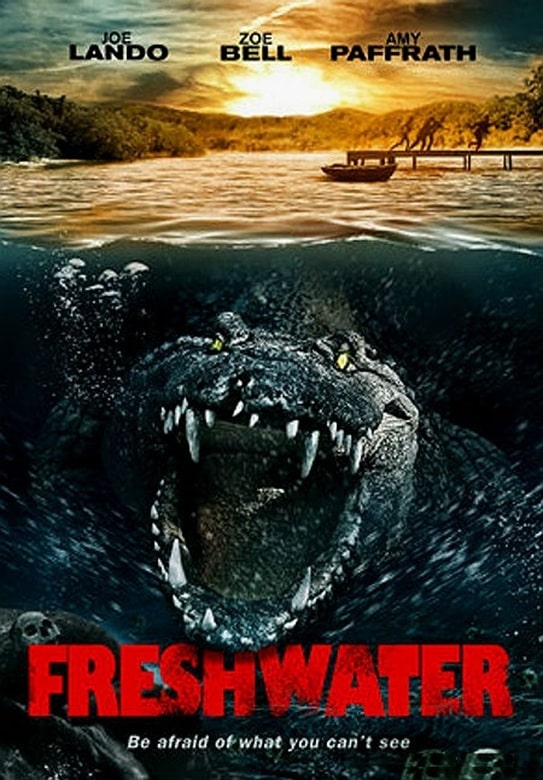
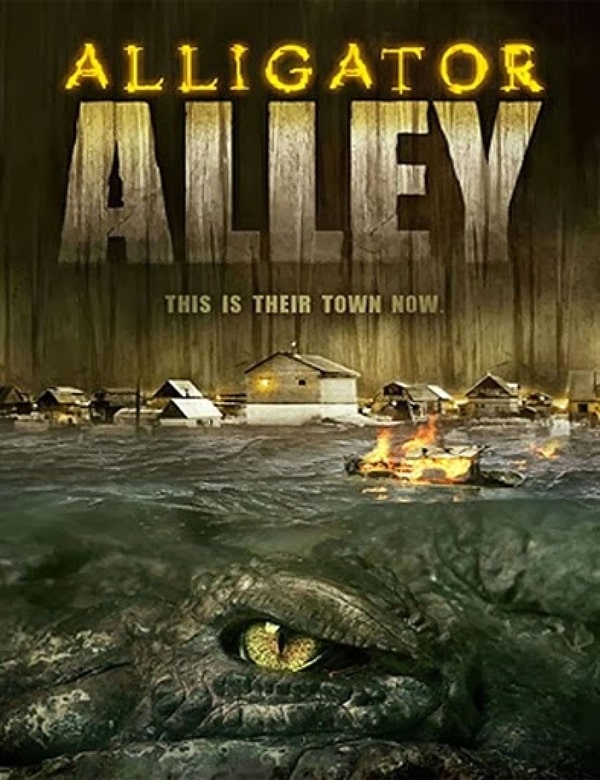
Freshwater (MultiVisionnaire, February 26, 2016) and Alligator Alley (Active Entertainment, 2013)
Croc or gator? Gator, possibly.
Real or faker? Let’s just say, when we do see a gator, it’s rubbish.
Any good? I’m torn, and not in a good way. There’s an awful lot wrong with this one, the script, the directing, the editing, the score (dear God, that score), most of the acting, the effects, and yet it tries something different (no spoilers, but it’s not what I was expecting) and I applaud the ballsy ending.
However, when the intended humor falls flat but your audience laughs at everything else, that ain’t good. Makes for a good drinking game if you are counting poor decisions (the first being to watch this optimistically).
5/10
Alligator Alley (2013) YouTubeCroc or gator? Gators!
Real or faker? Reasonably dodgy CG.
Any good? Also known as Ragin Cajun Redneck Gators, you know exactly what to expect going into this SyFy slice of grilled ham, and yet it upends those expectations with a hearty fart in the face. Toxic moonshine mutates gators into dart firing rascals whose bites turn folks into more gators (I kid you not). It’s all set against the backdrop of a family feud down south, and is as ludicrous as you might imagine.
It’s rubbish, but it’s daft rubbish, which is about as good as it gets these days, so I’m not hating it.
6/10
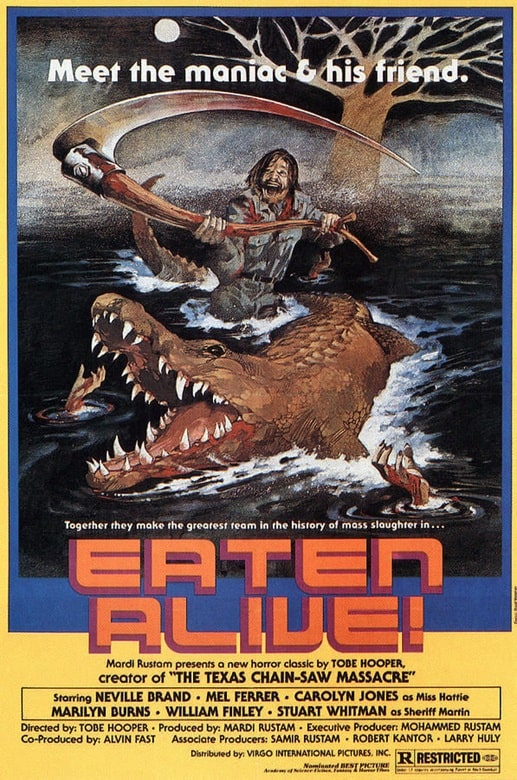
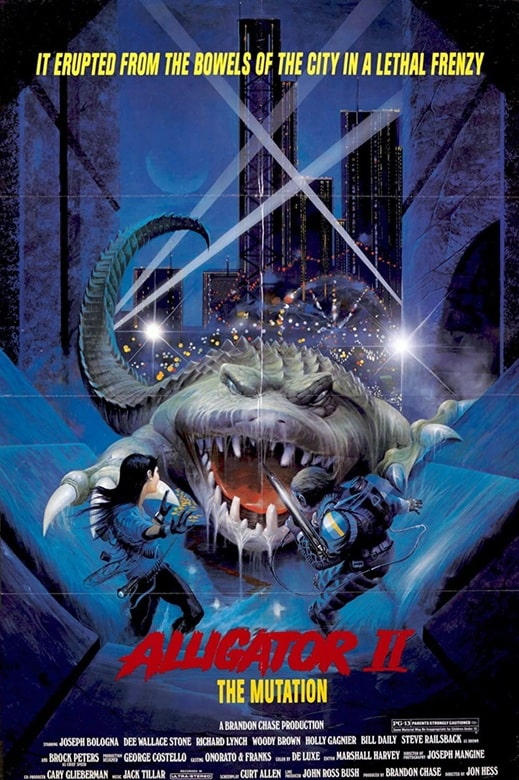
Eaten Alive (Mars Productions, October 18, 1976) and Alligator II: The Mutation (New Line Cinema, June 5, 1991)
Croc or gator? Nile Croc!
Real or faker? Cute papier mache monster.
Any good? Some good has come out of this ill-considered project, for I have finally watched the missing Tobe Hooper film in my life — a film banned in the UK until 1998 as part of Mary Whitehouse’s Video Nasty apocalypse. Though tame by today’s standards, the film does come with a warning for modern audiences as besides a bit of gore, it contains racial slurs and attempted rape.
This is Robert Englund’s first film role, and his big screen intro is “My name’s Buck, and I’m here to fuck.” Funny to think that he was roomies with Mark Hamill at the time, who was busy on his own little film.
The entire film is shot on a soundstage, and although the grimy motel is impressive enough, the exterior shots have an unearthly quality to them, surreal, dreamlike, bathed in red neon and resembling the last days. It’s atmospheric as all heck, with killer sound design, but it might be an uncomfortable watch for some (women are only present to get undressed). Neville Brand as the Norman Bates-ish ‘Judd’ is excellent, and the croc itself gets to do some fun chomping.
8/10
Alligator 2: The Mutation (1991) YouTubeCroc or gator? Alligator.
Real or faker? Stock footage and a rubbish puppet.
Any good? 11 years after the excellent and enjoyable first movie, someone decided to remake it, but make it boring. This film is missing two key ingredients, Robert Forster and a decent alligator.
Richard Lynch, Steve Railsback and Dee Wallace are welcome additions, but even they can’t save this dull ordeal. The story is the same as the first — a sewer alligator grows big and mean due to toxic waste, a corrupt businessman throws a party, rinse, repeat. However, where the first film kept its tongue in its cheek and actually showed us a big ol’ alligator, this one relegates its rubbish effects to the dark of the sewers, ensuring we see nothing for most of the film. Dull.
4/10
 The Alligator People (20th Century Fox, July 22, 1959)
The Alligator People (1959) Disney+
The Alligator People (20th Century Fox, July 22, 1959)
The Alligator People (1959) Disney+
Croc or gator? Alligator people!
Real or faker? Real gators and some great makeup.
Any good? One of those classics that somehow passed me by — I suspect the hokey still used in every book didn’t inspire much confidence in me — but I was horribly mistaken. Far from being the B-movie cheesefest I was expecting, it was surprisingly compelling, with a decent plot, lovely writing (the narration is poetic) and makeup by none other than Ben Nye and Dick Smith!
Lon Chaney is creepy as all heck, Beverly Garland is lovely, and the whole affair drips atmosphere and dangly moss. There’s a bit of abuse aimed at some (real) gators, so animal lovers beware, but I ended up both enthralled and charmed and I’m very happy to finally tuck this one away.
8/10
Previous Murkey Movie surveys from Neil Baker include:
What a Croc, Part I
Prehistrionics
Jumping the Shark
Alien Overlords
Biggus Footus
I Like Big Bugs and I Cannot Lie
The Weird, Weird West
Warrior Women Watch-a-thon
Neil Baker’s last article for us was What a Croc, Part I. Neil spends his days watching dodgy movies, most of them terrible, in the hope that you might be inspired to watch them too. He is often asked why he doesn’t watch ‘proper’ films, and he honestly doesn’t have a good answer. He is an author, illustrator, outdoor educator and owner of April Moon Books (AprilMoonBooks.com).
Teaser Tuesdays - The Spellshop
 Kiela never thought the flames would reach the library. She was dimly aware that most of the other librarians had fled weeks ago, when the revolutionaries took the palace and defenestrated the emperor in a rather dramatic display.
Kiela never thought the flames would reach the library. She was dimly aware that most of the other librarians had fled weeks ago, when the revolutionaries took the palace and defenestrated the emperor in a rather dramatic display.(page 1, The Spellshop by Sarah Beth Durst)
---------
Teaser Tuesdays is a weekly bookish meme, previously hosted by MizB of Should Be Reading. Anyone can play along! Just do the following: - Grab your current read - Open to a random page - Share two (2) “teaser” sentences from somewhere on that page BE CAREFUL NOT TO INCLUDE SPOILERS! (make sure that what you share doesn’t give too much away! You don’t want to ruin the book for others!) - Share the title & author, too, so that other TT participants can add the book to their TBR Lists if they like your teasers!
A HOUSE with GOOD BONES by T. Kingfisher
Monday Musings: Here We Are

 We woke this morning to a snow squall, something that happened with ever-decreasing frequency during our years in Tennessee, as climate change made the warm South even warmer. Here in New York, during the winter months, snow is still the default when there’s precipitation, and I love that. I have missed snow and don’t mind paying the plow guy or dealing with snow on the walkways and driveway. The beauty of an early morning snowfall more than makes up for the inconveniences.
We woke this morning to a snow squall, something that happened with ever-decreasing frequency during our years in Tennessee, as climate change made the warm South even warmer. Here in New York, during the winter months, snow is still the default when there’s precipitation, and I love that. I have missed snow and don’t mind paying the plow guy or dealing with snow on the walkways and driveway. The beauty of an early morning snowfall more than makes up for the inconveniences.
We have bird feeders up now, and they’ve drawn in a variety of species, including several species of sparrow, goldfinches and cardinals, chickadees and nuthatches and woodpeckers. They have also drawn the attention of local hawks, who seem to view our feeders as an all-they-can-eat avian buffet. We have a Cooper’s Hawk who frequents the yard, a pair of Red-tails who come around quite often, and, as of yesterday, a gorgeous Red-shouldered Hawk. Our turkey flock continues to wander through the yard now and then, as does a beautiful red fox. A couple of weeks ago, while driving past the farm that borders our property on the western edge, I spotted a young Peregrine Falcon perched on a telephone pole, hungrily eyeing a flock of doves.
I haven’t written in this blog for a few weeks, and in a way what you’ve just read is why. I am working again, we have settled into a routine of sorts. The house still needs a good deal of work, and we’re getting around to that slowly, steadily. We are enjoying this setting immensely. We’re eating fun foods and finding new stuff to stream. We’re spending lots of time with my brother and his family, who live close by, and lots of time with my college roommate and musical partner and his wife, who also live maybe 20 minutes from here.
Life is comfortable and peaceful and, I will also admit, a tiny bit boring. Not to me, mind you, but I can definitely see where it could seem that way to those on the outside. We traveled a lot last year. This year we’re planning to (mostly) stay put and work on our new place. The past several years have been full and fraught, difficult beyond words at times, and at other times so frantic as to be exhausting. This year won’t be like that. Not if we can help it.
And so, yeah, I have struggled to post. I don’t want to bore. I don’t want to repeat material from old posts.
I continue to grieve for my older daughter. I’ll never stop. But I feel I have made that grief part of my life, part of who I am now, and honestly, I wouldn’t have it any other way. I don’t feel the same need to write about it that I felt last year. And I think many grew tired of such posts. Grief is part of me, but it does not — should not — define me.
I don’t really want to think about the slow-motion disaster unfolding in our nation’s capital. This administration’s attempts to subvert the Constitution and undo a century of progress on Civil Rights, environmental protection, social justice, and a host of other worthy goals is not something upon which I care to dwell. I am too weary to engage in online flame wars with troglodytes and nazis. At some point, I’ll grow angry enough to write a political screed or three, but not now.
And at some point, I am sure, I will have much to say about new writing projects. For now, though, I’m merely editing, and enjoying quiet, productive days in my new work space.
All of this feels healthy, and deeply appropriate for this current stage of my life. None of it makes for exciting reading (or writing). I will do my best to post as I can, to come up with things to say that make something worth reading out of our mundane-albeit-cozy existence. But to those who know us and care about us, please be assured that we are doing well. Better than we would have thought possible a little over a year ago. Some days are harder than others. But we are where we ought to be, physically and emotionally. It’s hard to ask for more.
Wishing all of you a wonderful week.
Spotlight on “Flux” by Jinwoo Chong
Flux is a New York Times Editor’s Choice, Best Book of 2023 by Esquire, Apple…
The post Spotlight on “Flux” by Jinwoo Chong appeared first on LitStack.
Looking Back at RTS – and Myth: The Fallen Lords
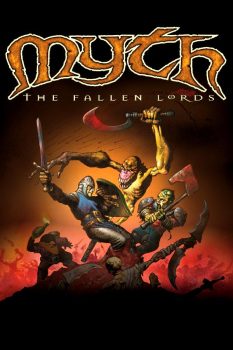 So….one of the rabbit holes I periodically jump down is Total War: Warhammer II. That’s easily my favorite in the Total War series (I played a boatload of TW: I as well. You can use units from I, in II, in some campaigns, which increases the utility of the first game. I appreciate that.
So….one of the rabbit holes I periodically jump down is Total War: Warhammer II. That’s easily my favorite in the Total War series (I played a boatload of TW: I as well. You can use units from I, in II, in some campaigns, which increases the utility of the first game. I appreciate that.
I struggle with the first 15-or-so turns, and frequently abandon a new game, pick another faction, and try again. I like playing different factions, so that’s fine. Also, I often plateau around 70-75 turns, and start a new game as well.
I reinstalled TW: I and II last month and have been playing again. It’s been fun. After a half-dozen false starts, I’m having one of my most successful games leading a chivalry-based, Middle Ages-type faction (WH is a fantasy world, with elves, orcs, beastmen, etc). And I realized I was applying the principles that George Washington advised America about in his famous Farewell Address. Being a Constitutional Convention of 1787 wonk, I’m reasonably familiar with Washington, who presided over the Convention.
However, as I type this right now, it is obvious that such a post is definitely not gonna be ready for tomorrow morning (which would be when this one went live – Monday the 3rd.
And let met tell you, there are multiple elements of Washington’s Address that apply today. Including about people in the country undermining it by pitting one group against another. And that applies to quite a few groups/people…
So instead, we’re talking about a few Real Time Strategy (RTS) games I’ve played over the years. The basic definition of RTS is games that don’t move forward incrementally in turns, but move along in ‘real time.’
The old Warcraft: Orcs and Humans was the first one I really got into, way back in the mid-nineties, which was the birth era of RTS. I never played World of Warcraft, but I ate up the first two Warcraft games (Starcraft followed, and was also immensely popular, but I never tried that one).
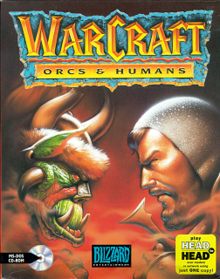 I think I played Command and Conquer for a very short time, but I don’t really remember that. It was kind of a high point of that style of RTS.
I think I played Command and Conquer for a very short time, but I don’t really remember that. It was kind of a high point of that style of RTS.
Age of Empires came along a few years later, and I played the heck out of that, as well as Age of Empires II. Both got rehabs and updates, and AoE II is totally playable. A buddy of mine is still addicted to the new version. AoE II is a classic which is still growing.
A few years ago, my son and I played a LOT of Star Wars: Empire at War, which came out in 2006. It swapped out resource gathering with a point-of-control system. It is a ton of fun.
For a Tolkien fan, Battle for Middle Earth I was fantastic. I didn’t play II, which I’ve heard was even better. It is possible to find an updated version of II that runs on modern Windows, but I haven’t managed to make that happen. Might really dial in on it sometime, and try. I was REALLY good for Tolkien fans.
There was a decent-enough D&D knock-off version, Dragonshard, in 2005. It mixed in a bit more RPG elements. I played it some, but Battle for Middle Earth was definitely superior.
Sid Meier is possibly the greatest game-creator of all time, with Civilization one of the most influential and popular games ever. His first game after leaving MicroProse was Sid Meier’s Gettysburg!, and it is a terrific Civil War game. You need to be totally immersed in it, but it’s a great Civil War game. Sid Meier’s Antietam! was similar.
And Railroad Tycoon was the standard railroad sim for a long time. 2018’s Railway Empire was a blast, and I have played that a fair amount.
I think it’s definitely cool that RTS is not limited to combat games (there are RTS World War games as well – I’ve only dabbled in those). Tropico, and Sim City, are two examples of RTS-type city-building games. I played a LOT of the first Tropico – that’s a fun game.
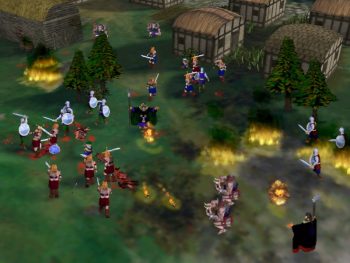 The only game that rivals TW:WH II for me, came out WAAAY back in 1997. Man, how can that be almost 30 years ago? I feel really old. But Bungie’s Myth: The Fallen Lords, was a terrific achievement. Story and game-play: just the EXPERIENCE.
The only game that rivals TW:WH II for me, came out WAAAY back in 1997. Man, how can that be almost 30 years ago? I feel really old. But Bungie’s Myth: The Fallen Lords, was a terrific achievement. Story and game-play: just the EXPERIENCE.
The land has fallen under almost total control of the forces of light (The Fallen Lords), led by Balor. The Light is led by powerful sorcerers, and you control an elite army unit called The Legion. You need to overcome The Fallen Lords. The developers cited Mel Gibson’s Braveheart, and Glen Cook’s fantastic The Black Company (you surely read my interview with him, here), as inspirations.
It is actually an RTT (Real Time Tactical) game. No resource gathering, no settlement growing. You don’t develop skill trees and build up unit strength. You start each scenario with your force fully ready to go.
It was essentially a unit-based combat game (NOT turn-based). But playing it still felt like a combat-based RTS, back then. Terrain and weather impacted things, which was neat at the time. You controlled units (usually in groups) to win battles. And no game I ever played had friendly fire as such a part of it. Those dwarven Molotov cocktails could take out your own forces.
Project Magma has converted the game to operate on current Windows systems. If I could focus in on it, I would probably go through the multiple steps and play this again. But TW: WH I, and II, are already installed, ready to play, and twenty years newer. Still, Myth Lords is one I’m tempted to try.
There was a sequel, and a prequel. But that original game is a masterpiece.

Bob Byrne’s ‘A (Black) Gat in the Hand’ made its Black Gate debut in 2018 and has returned every summer since.
His ‘The Public Life of Sherlock Holmes’ column ran every Monday morning at Black Gate from March, 2014 through March, 2017. And he irregularly posts on Rex Stout’s gargantuan detective in ‘Nero Wolfe’s Brownstone.’ He is a member of the Praed Street Irregulars, founded www.SolarPons.com (the only website dedicated to the ‘Sherlock Holmes of Praed Street’).
He organized Black Gate’s award-nominated ‘Discovering Robert E. Howard’ series, as well as the award-winning ‘Hither Came Conan’ series. Which is now part of THE Definitive guide to Conan. He also organized 2023’s ‘Talking Tolkien.’
He has contributed stories to The MX Book of New Sherlock Holmes Stories — Parts III, IV, V, VI, XXI, and XXXIII.
He has written introductions for Steeger Books, and appeared in several magazines, including Black Mask, Sherlock Holmes Mystery Magazine, The Strand Magazine, and Sherlock Magazine.
Book review: The Devil By Name by Keith Rosson (Fever House #2)

ABOUT THE AUTHOR: Keith Rosson is the author of the novels The Mercy of the Tide and Smoke City, and his short fiction has appeared in Cream City Review, PANK, December, The Nervous Breakdown, and more. He's been twice nominated for a Pushcart Prize and a finalist for the Birdwhistle Prize for Short Fiction. He’s also an illustrator and graphic designer, with clients that include Green Day, Against Me, the Goo Goo Dolls, and others. A fierce advocate of public libraries and non-ironic adulation of the cassette tape, he can be found at keithrosson.com.
Publisher: Random House (September 10, 2024) Length: 400 pages Formats: audiobook, ebook, paperback
The Devil by Name picks up five years after Fever House with all the chaos, gore, and gripping drama you’d expect—and then some. The world is still reeling from “The Message,” a weaponized sound that turned much of humanity into bloodthirsty monsters called the fevered. With Terradyne Industries running the show and humanity clinging to survival, the stakes have never been higher.
The book is a wild ride; it takes elements of horror, noir, and spy thriller vibes and turns them into a splatterfest that somehow still manages to be emotionally grounded. John Bonner, riddled with guilt and desperate for redemption, Katherine Moriarty, coping with devastating loss, and Naomi Laurent, a teenager with a mysterious, world-altering gift, are all struggling. Newcomer Dean Haggerty, a warm, resourceful scavenger, is an unexpected bright spot, bringing a glimmer of hope to a grim story.
Yes, the gore is intense, and the body horror will stick with you long after you’ve turned the last page (looking at you, “tortured fevered in the chair”). But here’s the thing - Rosson knows how to find a balance between the carnage and emotional depth, and his take on grief, redemption, and survival feels raw and real. The character arcs are top-notch, with even minor players leaving a mark. Katherine’s transformation, in particular, is spectacular.
The pacing is relentless, and while some plot conveniences (a possible cure-all across the ocean, for example) might raise an eyebrow, the story’s intensity and emotional pull make it easy to forgive. Rosson ties up loose ends from Fever House while introducing fresh twists, taking the story in surprising directions.
The final chapters are pure nightmare fuel, and the emotional punches hit hard. If you’re into stories that mix terror, heart, and a touch of hope, The Devil by Name delivers big time. It’s the kind of book that leaves you a little haunted but entirely satisfied.
Snake Eyes by Mark Henwick
Urban Fantasy
This is book 8 in the Amber Farrell / Bite Back series. To start at the beginning read the novella Raw Deal or Book 1, Sleight of Hand.

The first four of five books in the series were very much about discovery. Amber Farrell who is vampire, werewolf and witch was learning who she was. All the while battling the bad guys and each supernatural community where she was considered an abomination.
The more recent books have been about joining her separate parts, I guess “becoming” is a good word. And the last couple of books, Queen of Diamonds and Snake Eyes (essentially one book broken into two parts) seem to me to be her arriving at who she is.
This series is honestly one of the best. If you look at the books I read, you’ll notice 90% plus are written by women. Mark Henwick is one of a handful of male authors I read and reread. I’ve probably read most of the books in this series a dozen times. So if you love Urban Fantasy, do yourself a favour. Read Amber Farrell.
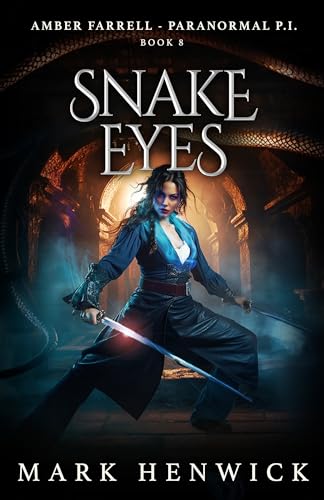
Audiobook Review: Tartufo by Kira Jane Buxton
I received a review copy from the publisher. This does not affect the contents of my review and all opinions are my own.
Mogsy’s Rating (Overall): 3.5 of 5 stars
Genre: Contemporary, Humor
Series: Stand Alone
Publisher: Hachette Audio (January 28, 2025)
Length: 11 hrs and 31 mins
AuthorInformation: Website | Twitter
Narrator: Caroline Hewitt
After thoroughly enjoying Kira Jane Buxton’s Hollow Kingdom series, I was looking forward to checking out Tartufo even though her newest novel falls outside my usual genres. I was mainly curious to see how her quirky sense of humor would transfer to a different kind of story, and while Tartufo does indeed take a more grounded approach, it still carries the author’s signature charm. Still, despite its playfulness and whimsy, the novel didn’t quite capture me in the same way as her previous work.
Set in the small, fictional Italian village of Lazzarini Boscarino, Tartufo tells the tale of a group of residents who will do anything to keep their dying town on the map. With most of the younger generation having departed for greener pastures in the big cities, the remaining aging population is left to hold what’s left of their beloved home together. But the crisis deepens as it is revealed that the previous mayor had died without leaving any available funds for rebuilding and revitalizing. Now his daughter Delizia returns home to handle his affairs only to find herself elected as the new mayor—after nearly losing the race to a donkey—with the unenviable task of turning things around, all the while struggling with her own personal ambitions and disappointments.
Then one day, a local truffle hunter named Giovanni heads out into the forest with his dogs, doing what he loves most, when he suddenly stumbles upon an enormous truffle—quite possibly the largest specimen the world has ever seen. Realizing its potential, Giovanni brings it to the rest of the village, hoping it’s exactly what they need to bring attention back to Lazzarini Boscarino. However, what begins as a stroke of extraordinary luck soon spirals out of control as the attention the town receives also includes that of the negative variety, motivated by enmity and greed. Instead of bringing the community together, the discovery of the truffle threatens do the exactly opposite, forcing everyone to question what future they want for their town.
If you’re looking for some casual reading or a book to sit back and relax with, Tartufo is the perfect choice—relatively low stakes, brimming with charm and wit. For me, it felt a lot like watching a lighthearted musical. The human characters are oddballs, with some portrayals leaning into satire and caricature, filling the cast with over-the-top personalities that wouldn’t feel too out of place in a stage comedy. The novel is also a treat for the senses. Descriptive writing is dialed up to the max, painting a gorgeously evocative picture of the setting. The Italian countryside is described so vividly you can practically smell the delicious scent of food and wine in the restaurants and feel the warmth under the Mediterranean sun. The village of Lazzarini Boscarino is itself as much a character as its eccentric inhabitants, written with the same amount of care and detail.
Buxton has also chosen to tell this story in an omniscient point of view, a brilliant decision which allowed her to do something that has become part of her signature style—writing from the perspective of animals. Inserted between character POVs are scenes told through the eyes of creatures like Giovanni’s truffle-hunting dog, a cat named Al Pacino (despite it being female), and even a passing honeybee. Not only is it reminiscent of the Hollow Kingdom series, which was told through the eyes of a very clever crow, it’s a quirk of the writing which adds an unexpected layer of depth to the story.
Despite the whimsical nature of Tartufo, there’s a distinct lack of supernatural elements, though that alone didn’t take away from my enjoyment. More challenging was the way the narrative juggles so many different POVs, leaving some important characters underdeveloped. It’s also a little too silly in places, making it harder for me to fully immerse myself in the conflict, and there were moments where I wished for more emotional depth.
Nevertheless, Tartufo remains a delightful read, showcasing Kira Jane Buxton’s storytelling abilities. While the playful tone occasionally goes overboard with it and becomes tiresome, on the whole the book is entertaining and endearing. At its heart, it’s a story about togetherness and the dreams of a community, and though I didn’t connect with it as deeply as the author’s Hollow Kingdom, I still had a good time with its humor and themes.
![]()
![]()
The Fiction of Edgar Rice Burroughs, Part II: Tarzan and The Land That Time Forgot
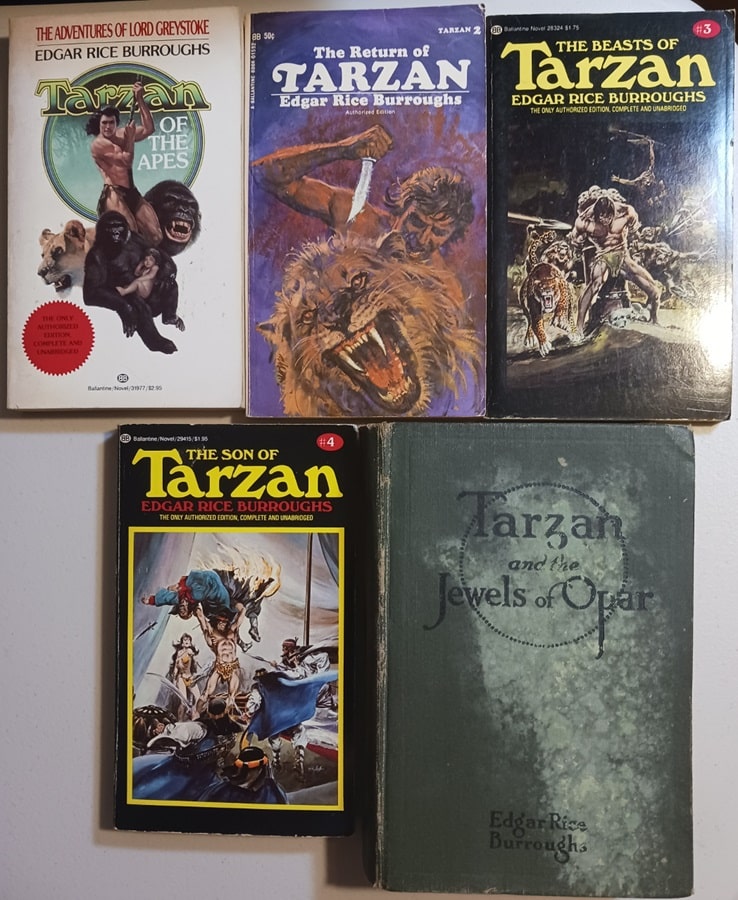 Tarzan novels #1 – #5 : Tarzan of the Apes, The Return of Tarzan, The Beasts of Tarzan, and The Son of Tarzan (Ballantine Books, December 1983, April 1969, April 1975, April 1975), and Tarzan and the Jewels of Opar (A.L. Burt, 1919). Covers by Charles Ren, Bob Abbett, Neal Adams, and Neal Adams.
Tarzan novels #1 – #5 : Tarzan of the Apes, The Return of Tarzan, The Beasts of Tarzan, and The Son of Tarzan (Ballantine Books, December 1983, April 1969, April 1975, April 1975), and Tarzan and the Jewels of Opar (A.L. Burt, 1919). Covers by Charles Ren, Bob Abbett, Neal Adams, and Neal Adams.
Any discussion of Sword & Planet fiction needs to start with Edgar Rice Burroughs and his book A Princess of Mars. I discussed that series extensively — and also his other S&P series, the Carson of Venus books, and his Moon Maid trilogy, which is partially S&P — in Part I of this series.
But, of course, ERB wrote many other books that have no connection to S&P fiction. They are still very good stories, though, entertaining and worth discussing. I thought I’d cover some in my next series of posts.
Most readers I know discovered ERB through the character of Tarzan. The first ERB I read was A Princess of Mars, but the second one was Tarzan Lord of the Jungle. The book was an old hardback, with no dust cover. The cover was generally brown with the title embossed on it. I found it among my sister’s books. She was the only other big reader in my family. I don’t know how she came upon it. I still remember some fifty+ years later the opening scene, with Tarzan dozing on the back of Tantor the elephant. And before long Tarzan finds a lost civilization of crusaders in deepest Africa. And there was swashbuckling.
[Click the images for Tarzan-sized versions.]
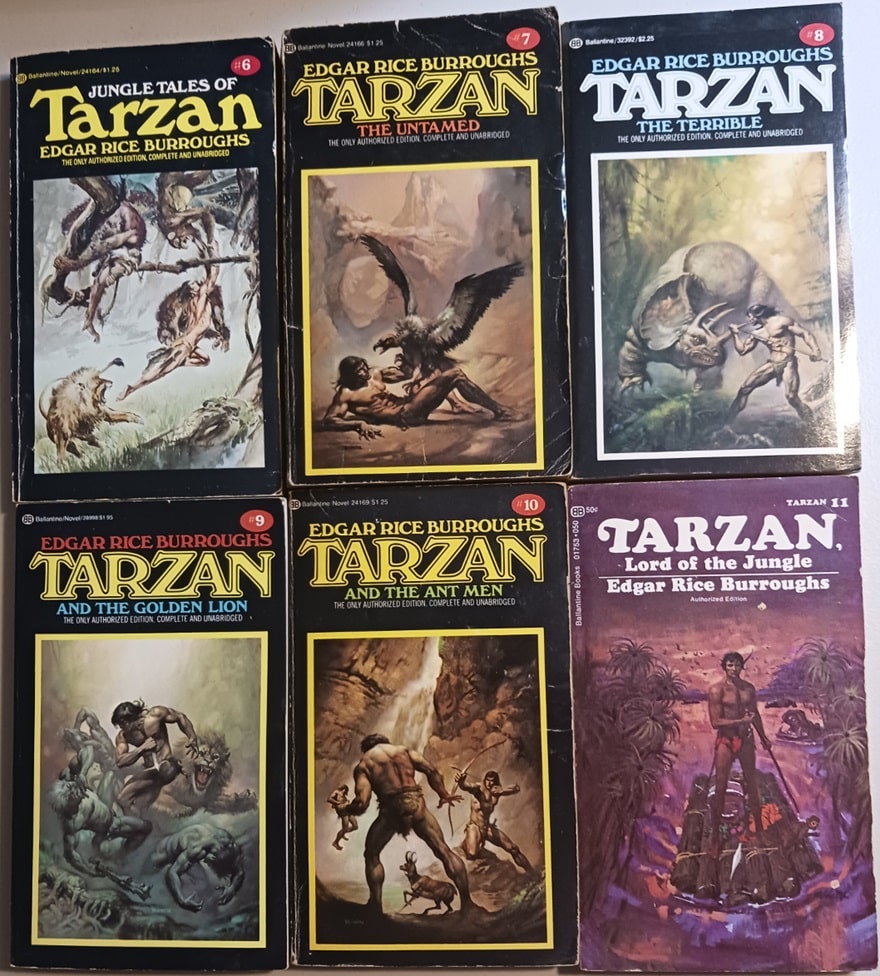 Tarzan #6 – #11: Jungle Tales of Tarzan, Tarzan the Untamed, Tarzan the Terrible, Tarzan and the Golden Lion, Tarzan and the Ant Men, and Tarzan, Lord of the Jungle (Ballantine Books, 1975-1976, and 1969). Covers by Neal Adams, Boris Vallejo, and Bob Abbett.
Tarzan #6 – #11: Jungle Tales of Tarzan, Tarzan the Untamed, Tarzan the Terrible, Tarzan and the Golden Lion, Tarzan and the Ant Men, and Tarzan, Lord of the Jungle (Ballantine Books, 1975-1976, and 1969). Covers by Neal Adams, Boris Vallejo, and Bob Abbett.
I’ve always liked best the Tarzan tales where he discovers a lost race. There were a lot of them in Africa, apparently. That copy of the book fell apart and I eventually replaced it with a paperback. When I started buying the Tarzan books I couldn’t afford to get them all at once, and I also picked up ones here and there from used bookstores or book sales. Most of the ones I found were from the Ballantine editions, many with great Boris Vallejo covers, which became my “mind’s eye” image of Tarzan.
Above I show the first 11 books in my collection. All but Jewels of Opar are from Ballantine, published between 1963 and 1973 it looks like. Covers are varied.
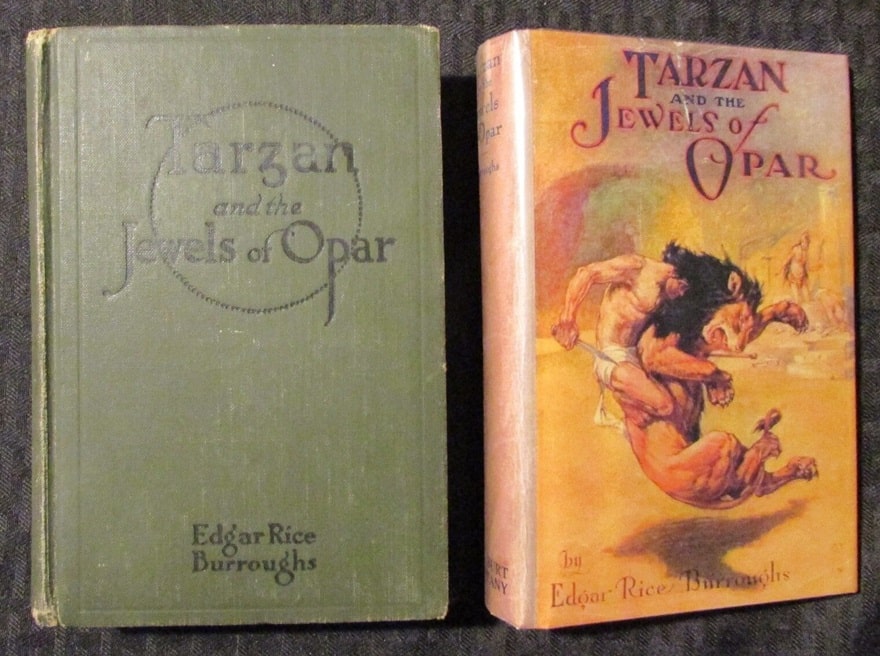 Tarzan and the Jewels of Opar (A.L. Burt Company, 1919). Cover by J. Allen St. John
Tarzan and the Jewels of Opar (A.L. Burt Company, 1919). Cover by J. Allen St. John
Here’s the list of cover artists.
Tarzan of the Apes; Charles Ren
The Return of Tarzan; Robert Abbett
Beasts of, Son of, Jungle Tales of; Neal Adams
Untamed, Terrible, Golden Lion, Ant Men; Boris Vallejo
Lord of the Jungle; Robert Abbett
My copy of Tarzan and the Jewels of Opar was published in 1919 by A. L. Burt Company. It lacks a dust cover, but above is a picture I took off the internet of what it apparently looked like. The beautiful cover is by J. Allen St. John (1872 – 1957), who was an incredible artist.
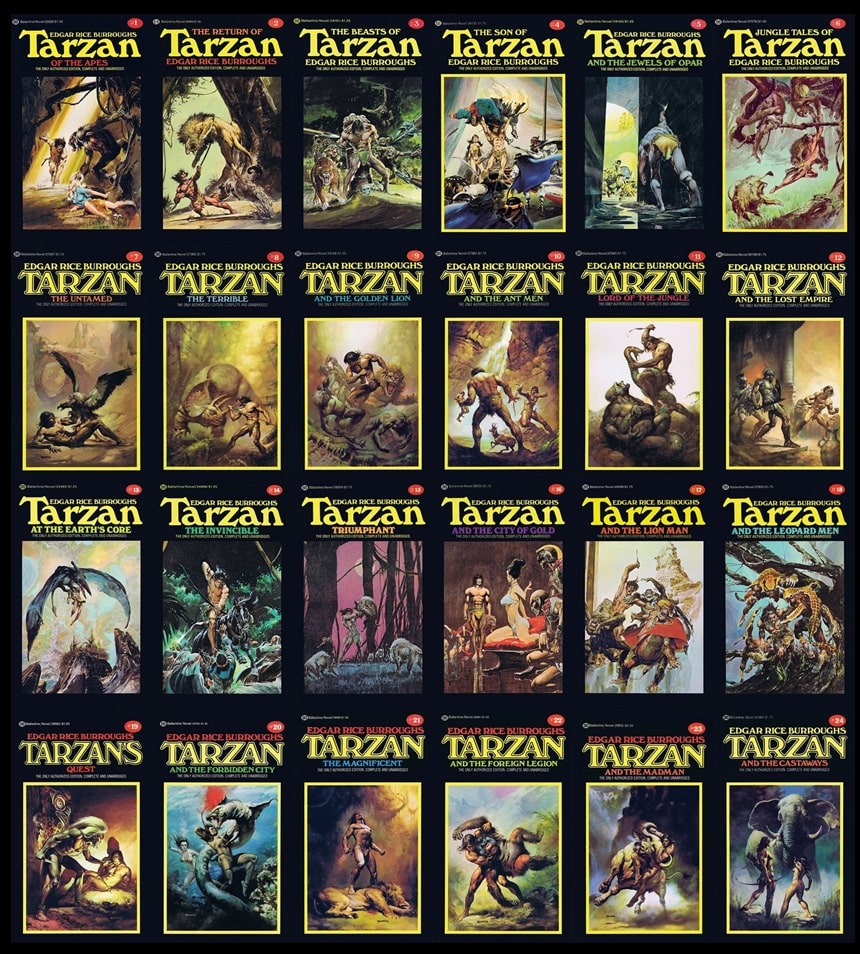 The 24 Tarzan novels and collections published in sequence in paperback by Ballantine Books, 1975 – 1977. Covers by Neal Adams and Boris Vallejo
The 24 Tarzan novels and collections published in sequence in paperback by Ballantine Books, 1975 – 1977. Covers by Neal Adams and Boris Vallejo
Burroughs wrote 26 books about Tarzan, but typically only 24 are counted as part of the main sequence. The two odd numbers out are The Tarzan Twins, which I have, and Tarzan and the Tarzan Twins with Jad-Bal-Ja The Golden Lion, which I’ve never seen. These are novellas written for young readers. They were published separately but were collected together at one point, although I can’t find a copy of that publication.
The copy of The Tarzan Twins that I have is from Wildside Press with a cover by Douglas Grant. It’s the only ERB book I don’t like and doesn’t even seem like ERB to me. ERB’s work was already accessible to young readers. Most people I know read them pretty young, so for him to “try” to write down to kids just didn’t work — at least to me.
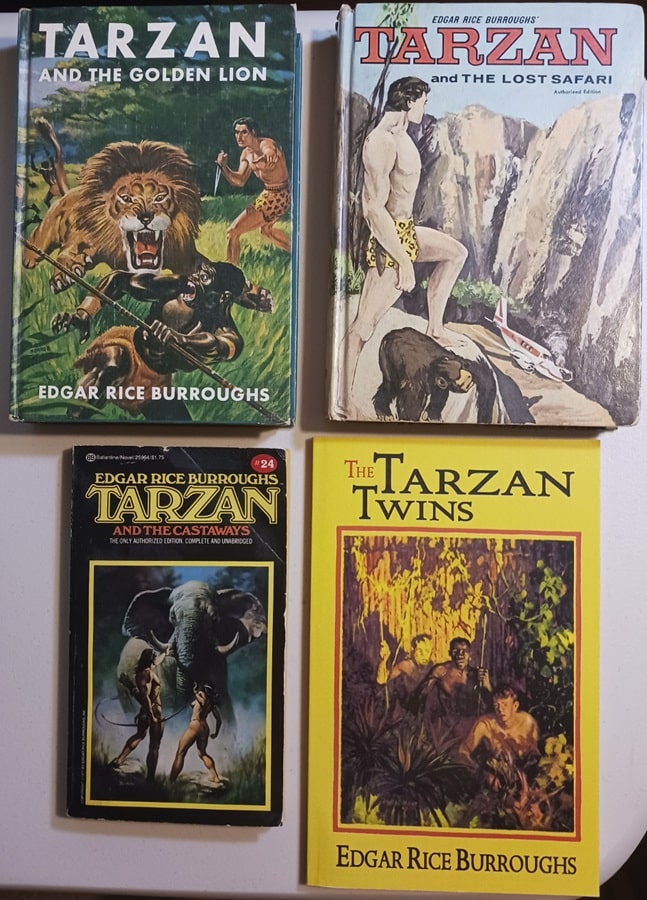 Tarzan and the Golden Lion (Grosset & Dunlap, 1949), Tarzan and the Lost Safari (Whitman Publishing, January 1, 1966, author unknown), Tarzan and the Castaways (Ballantine, September 1977), and The Tarzan Twins (Wildside Press, September 14, 2005). Covers by C. Edmund Monroe, Jr., Tony Sgroi, Boris Vallejo, and Douglas Grant.
Tarzan and the Golden Lion (Grosset & Dunlap, 1949), Tarzan and the Lost Safari (Whitman Publishing, January 1, 1966, author unknown), Tarzan and the Castaways (Ballantine, September 1977), and The Tarzan Twins (Wildside Press, September 14, 2005). Covers by C. Edmund Monroe, Jr., Tony Sgroi, Boris Vallejo, and Douglas Grant.
Overall, the Tarzan series is certainly not my favorite among ERB’s work anyway. They’re actually fairly low on my list of ERB favorites, although — don’t get me wrong — still very good. A ranking of my favorite series would be John Carter, Moon Maid, Carson of Venus, Land that Time Forgot, and Pellucidar, with Tarzan coming after that. Some of my favorite standalones would be The Outlaw of Torn, The Mad King, and I Am A Barbarian.
The Tarzan tales were almost certainly influenced by Rudyard Kipling’s jungle book tales of Mowgli, the wild boy of the forest — which in turn was influenced by some true reports from the mid-1800s of children in India being raised by wolves. ERB may have been directly aware of those same tales as well, and likely knew of the “Wild Boy of Aveyron,” who, around 1800, was found living in the wilds in France. The French feral child was named Victor by one of his “rescuers.” Unlike Tarzan, he never really learned to speak, although he apparently understood some language.
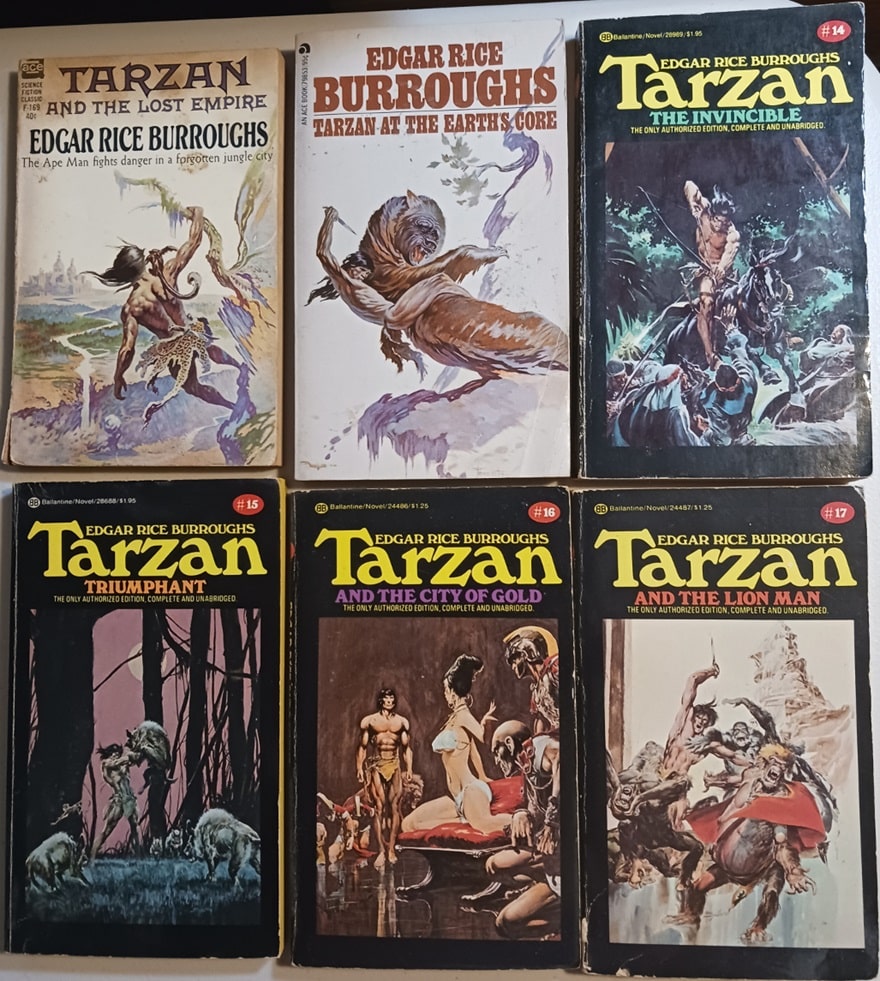 Tarzan #12 – #17: Tarzan and the Lost Empire and Tarzan at the Earth’s Core (Ace Books, November 1962 and March 1963), and Tarzan the Invincible, Tarzan Triumphant, Tarzan and the City of Gold, and Tarzan and the Lion Man (Ballantine Books, November 1975). Covers by Frank Frazetta and Neal Adams.
Tarzan #12 – #17: Tarzan and the Lost Empire and Tarzan at the Earth’s Core (Ace Books, November 1962 and March 1963), and Tarzan the Invincible, Tarzan Triumphant, Tarzan and the City of Gold, and Tarzan and the Lion Man (Ballantine Books, November 1975). Covers by Frank Frazetta and Neal Adams.
Above and below are the remaining Tarzan book pictures from my collection. The Ace copy of Lost Empire with the Frazetta cover that looks like it was inspired by Roy Krenkel Jr’s work is a real prize. I also have an Ace copy of Tarzan at the Earth’s Core, which also ties into ERB’s Pellucidar series, with a wonderful Frazetta cover.
The rest of my regular series are all Ballantine, with the following cover artists.
Invincible, Triumphant, City of Gold, Lion Man, Leopard Men; Neal Adams
Quest, Forbidden City, Magnificent, Foreign Legion, Madman, Castaways; Boris Vallejo
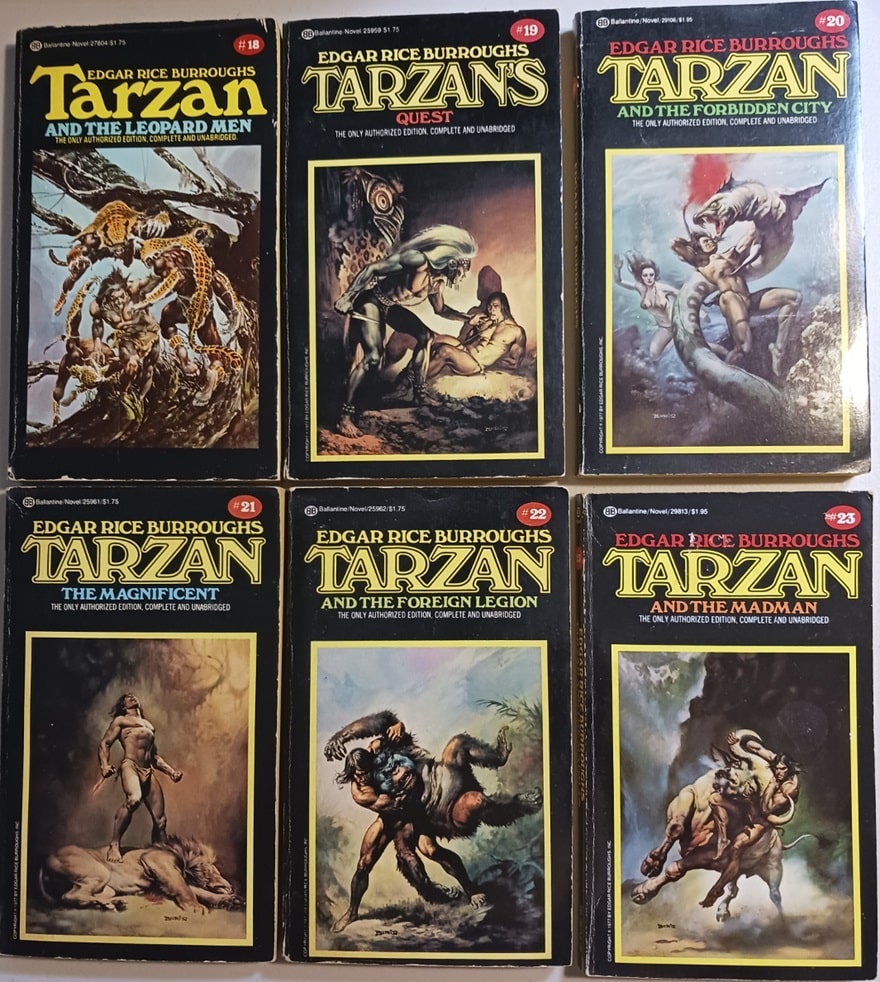 Tarzan #18 – #23: Tarzan and the Leopard Men ((Ballantine Books, November 1975, cover by Neal Adams), and Tarzan’s Quest, Tarzan and the Forbidden City, Tarzan the Magnificent, Tarzan and the Foreign Legion, and Tarzan and the Madman (Ballantine Books, September 1977, covers by Boris Vallejo).
Tarzan #18 – #23: Tarzan and the Leopard Men ((Ballantine Books, November 1975, cover by Neal Adams), and Tarzan’s Quest, Tarzan and the Forbidden City, Tarzan the Magnificent, Tarzan and the Foreign Legion, and Tarzan and the Madman (Ballantine Books, September 1977, covers by Boris Vallejo).
My second copy of Tarzan and the Golden Lion is from Grosset & Dunlap and clearly looks targeted toward younger readers with that cover (see above) — which is pretty cringeworthy for moderns. Not sure when it was published or who the cover artist might be.
Tarzan and the Lost Safari is adapted from the Tarzan movie of that same name. It was published by Whitman and doesn’t list an author, although I’ve seen Frank Castle’s name attached to it. I’ve seen this book for sale as by “Edgar Rice Burroughs.” It’s not. It’s closer to the movie Tarzan than to ERB’s creation. I didn’t find it very entertaining.
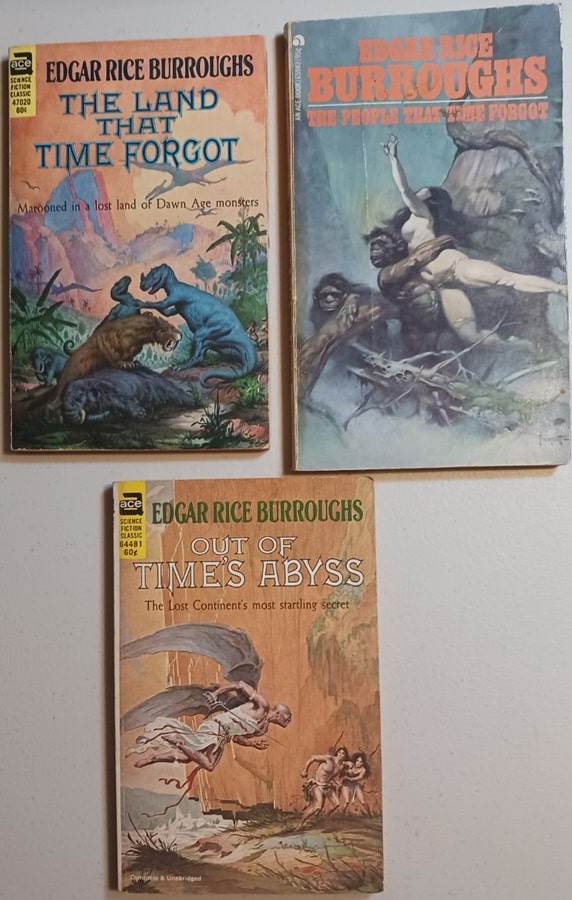 Three novels of The Lost Continent by Edgar Rice Burroughs: The Land That Time Forgot, The People That Time Forgot, and Out of Time’s Abyss (Ace Books, 1963, January 1973, and October 1963). Covers by Roy Krenkel, Jr, Frank Frazetta, and Roy Krenkel, Jr.
Three novels of The Lost Continent by Edgar Rice Burroughs: The Land That Time Forgot, The People That Time Forgot, and Out of Time’s Abyss (Ace Books, 1963, January 1973, and October 1963). Covers by Roy Krenkel, Jr, Frank Frazetta, and Roy Krenkel, Jr.
I personally don’t believe that ERB has been well served by the film and TV industries. I may be in the minority here but I find the early Tarzan movies to be virtually unwatchable. They seem to have very little to do with ERB’s characterization of Tarzan. The first Tarzan movie I actually liked was Greystoke: The Legend of Tarzan, starring Christopher Lambert. It still wasn’t the Tarzan I knew from the books but they made an effort to capture some of the character’s origins. I also liked most of the 2016 Legend of Tarzan, with Alexander Skarsgard, who I believe captured the essence of the character better than any previous Tarzan.
I generally liked the John Carter of Mars film, although they made changes that weren’t needed, but my favorite ERB adaptations are definitely a couple of B-movies starring Doug McClure. I’m talking about The People that Time Forgot, and The Land that Time Forgot. I’ve given these — especially the first one — frequent rewatches. Although the special effects are pretty awful by modern standards, the spirit of ERB’s stories shine through, the mystery and the exotic.
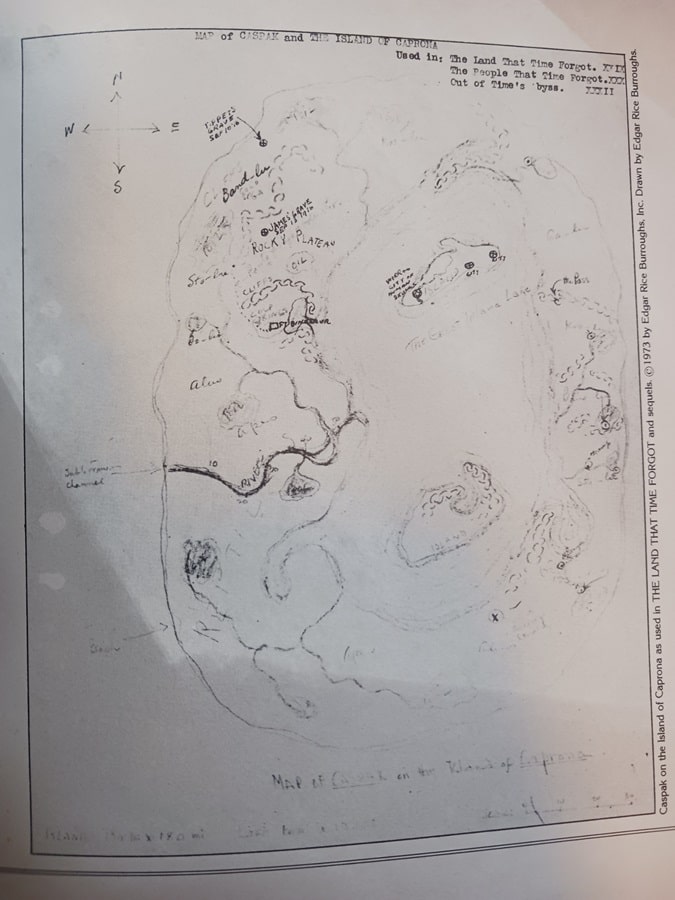 A map of Caprona, the Land that Time Forgot, from An Atlas of Fantasy by J. B. Post (Ballantine Books, 1979)
A map of Caprona, the Land that Time Forgot, from An Atlas of Fantasy by J. B. Post (Ballantine Books, 1979)
Of course, I loved the trilogy that spawned these movies — The Land that Time Forgot, The People that Time Forgot, and Out of Time’s Abyss. I thought Doug McClure did a good job with the character of Bowen Tyler, who becomes the first American to set foot on Caprona, a lost world near Antarctica where time seems to have stopped and dinosaurs still survive. There’s also a deep mystery about how things “evolve” on Caprona, though I won’t give it away.
Above are the three copies I have, all from Ace. Frazetta did the cover for The People while the other two are by Roy Krenkel, Jr. I’m also including a map of Caprona featured in An Atlas of Fantasy.
More on Burroughs next time.
Charles Gramlich administers The Swords & Planet League group on Facebook, where this post first appeared. His last article for Black Gate was The Fiction of Edgar Rice Burroughs, Part I: Sword and Planet.
The Intersection of Hobbies: Dungeons & Dragons, John Eric Holmes, and Tarzan
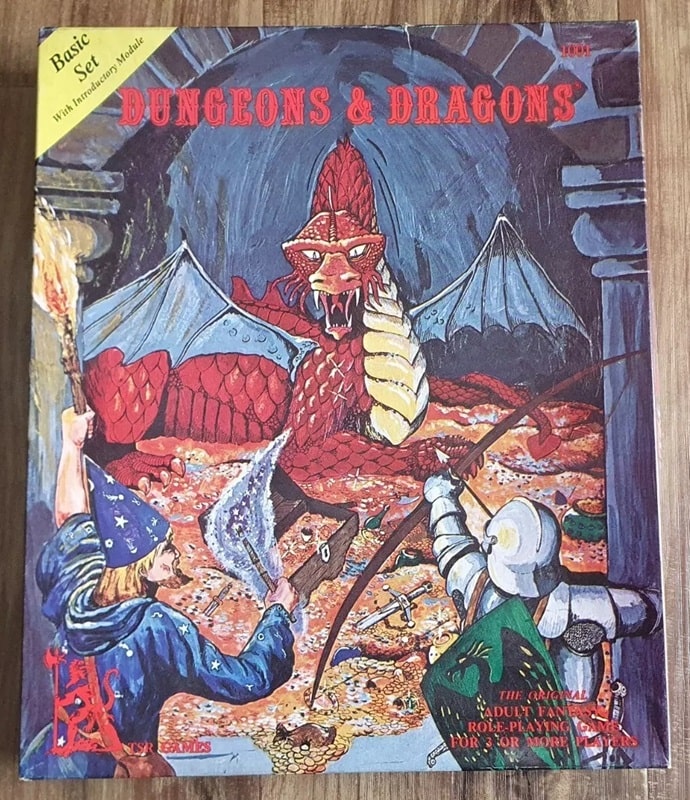 Dungeons & Dragons Basic Set by John Eric Holmes, based on Dungeons & Dragons by Gary Gygax and Dave Arneson (TSR Games, 1977). Cover by David Sutherland
Dungeons & Dragons Basic Set by John Eric Holmes, based on Dungeons & Dragons by Gary Gygax and Dave Arneson (TSR Games, 1977). Cover by David Sutherland
There are many intersections between my favorite hobby (which is also my line of work) and my favorite fiction. One of these intersections is represented by Dr. John Eric Holmes and the fiction of Edgar Rice Burroughs.
When I was a youth, the first Dungeons & Dragons set that I owned was edited by Dr. Holmes. That “basic” set served as the foundation to my understanding of all things D&D. Now, this was in 1981, when I was in the fifth grade. This was also the year in which I was devouring Tarzan novels, written by Edgar Rice Burroughs. My keen interest in Tarzan was fueled by the CBS Saturday morning cartoon, Tarzan, Lord of the Jungle.
[Click the images for Tarzan-sized versions.]
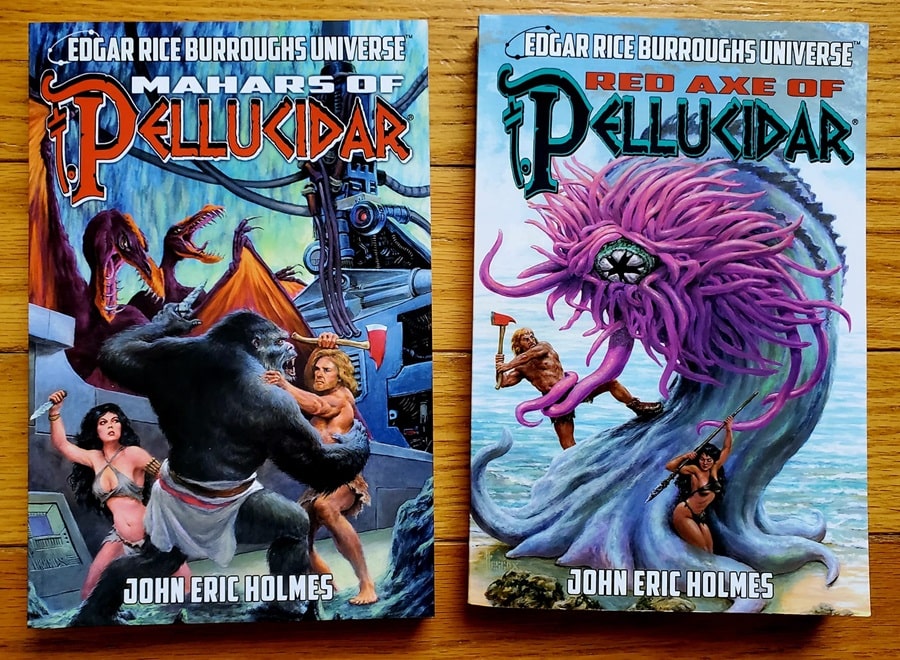 Pellucidar novels by John Eric Holmes: Mahars of Pellucidar and Red Axe of Pellucidar (Edgar Rice Burroughs, Inc., September 6, 2022). Covers by Richard Hescox
Pellucidar novels by John Eric Holmes: Mahars of Pellucidar and Red Axe of Pellucidar (Edgar Rice Burroughs, Inc., September 6, 2022). Covers by Richard Hescox
As I got older, I delved into other works by Burroughs, such as the Barsoom, Amtor, and Pellucidar stories. It wasn’t until recent years that I learned that Dr. Holmes had written two Pellucidar novels himself, the first of which was published in his lifetime, the other which was not: Mahars of Pellucidar and Red Axe of Pellucidar.
I am looking forward to reading these two books soon, probably spaced between my Zelazny readings. It’s nice to see that each of these books includes a foreword by Chris Holmes, one of Dr. Holmes’ children, whom I have had the pleasure to speak with several times at North Texas RPG Con.
 The complete Tarzan novels and collections by Edgar Rice Burroughs, published in paperback by Ballantine Books, 1975 – 1977. Covers by Neal Adams and Boris Vallejo
The complete Tarzan novels and collections by Edgar Rice Burroughs, published in paperback by Ballantine Books, 1975 – 1977. Covers by Neal Adams and Boris Vallejo
When I was young, my first exposure to Tarzan, created by Edgar Rice Burroughs, was the 1966 Tarzan TV series, starring Ron Ely. This was followed by the 1976–1980 animated series, Tarzan, Lord of the Jungle, which really captured my imagination.
I can still hear my brother Bob doing his “Bolmangani” voice from that cartoon. (The Bolmangani were evil gorilla-men that Tarzan often faced.) The show was excellent, and I particularly enjoyed the opening narration:
The jungle: Here I was born; and here my parents died when I was but an infant. I would have soon perished, too, had I not been found by a kindly she-ape named Kala, who adopted me as her own and taught me the ways of the wild. I learned quickly, and grew stronger each day, and now I share the friendship and trust of all jungle animals. The jungle is filled with beauty, and danger; and lost cities filled with good, and evil. This is my domain, and I protect those who come here; for I am Tarzan, Lord of the Jungle!
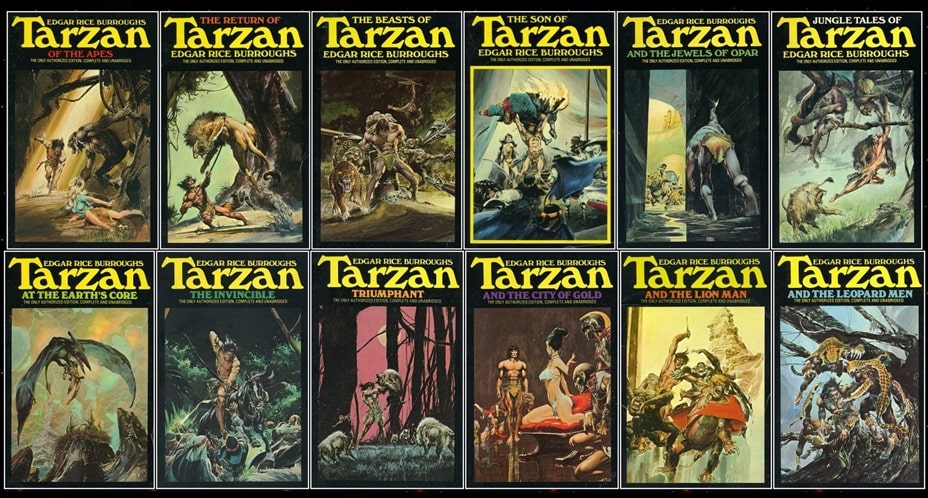 The twelve Neal Adams covers for the Ballantine Tarzan.
The twelve Neal Adams covers for the Ballantine Tarzan.
It was some time around 1981 that I began reading the actual ERB Tarzan books. I was completely enthralled within a few pages. The writing style of ERB was something like I’d never encountered before.
Pictured below is the cover art for the first Tarzan novel that I read, Tarzan of the Apes, published in 1977 by Ballantine Books. It was painted by Neal Adams, whose art was superb. In fact, I am of the opinion that Neal did the finest rendition of Batman to this day.
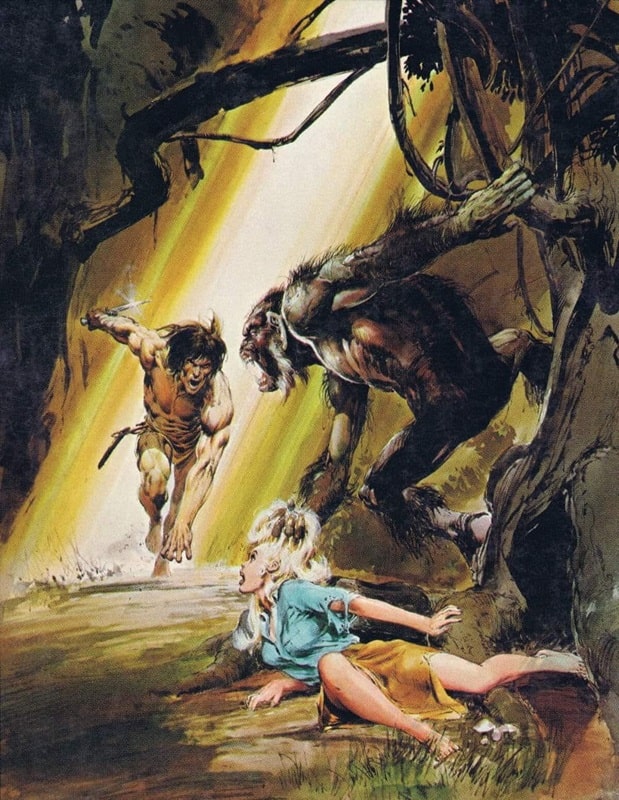 Cover art for Tarzan of the Apes by Neal Adams
Cover art for Tarzan of the Apes by Neal Adams
Anyway, the Neal Adams art is what drew me to purchase the first Tarzan book at my local Walden Books. It led me to a lifelong fascination with the incredibly imaginative works of Edgar Rice Burroughs.
In fact, I can open any ERB book to any random page, start reading, and find myself sucked into a world of wonder.
Jeffrey P. Talanian’s last article for Black Gate was Savage Sword of Conan is Back. He is the creator and publisher of the Hyperborea sword-and-sorcery and weird science-fantasy RPG from North Wind Adventures. He was the co-author, with E. Gary Gygax, of the Castle Zagyg releases, including several Yggsburgh city supplements, Castle Zagyg: The East Mark Gazetteer, and Castle Zagyg: The Upper Works. Read Gabe Gybing’s interview with Jeffrey here, and follow his latest projects on Facebook and at www.hyperborea.tv.
Is Sophie’s Choice a True Story? – Revisiting “Sophie’s Choice”
Is Sophie's Choice a true story? Styron based his novel on his memory of a real-life woman named Sophie, a survivor of Auschwitz he met in Brooklyn.
The post Is Sophie’s Choice a True Story? – Revisiting “Sophie’s Choice” appeared first on LitStack.
The Antidote
Fans of Barbara Kingsolver’s Demon Copperhead will want to grab this gorgeous magical-realist novel set on the Nebraska prairie during the height of the Dust Bowl climate disaster. Russell, a MacArthur grant winner, is best known for her collections of short stories, and this is only her second novel after the 2012 Pulitzer finalist Swamplandia! It is well worth the wait, offering a ferociously moving meditation on America’s refusal to come to terms with the violence and injustice of its own past. The story begins on “Black Sunday,” April 14, 1935, when tornadic dust storms destroyed farmland throughout the Great Plains, and a variety of point-of-view characters lead the reader to an intimate understanding of the Great Midwestern Drought that decimated the farmlands of the American prairie and worsened the Great Depression.
The premise sounds grim, but Russell draws on some of our most enchanting national myths to bring these characters to life. The alert reader will quickly realize that yes, this novel is set in the fictional town of Uz, Nebraska, in the depths of the Dust Bowl Depression, and yes, the inhabitants are menaced by dust tornados, and yes, the main characters are a scrappy orphan girl, a mysterious scarecrow, a stiff midwestern bachelor searching for love, and an exhausted prairie witch whose task it is to collect the toxic memories of her neighbors and store them away inside herself. But Russell’s evocations of L. Frank Baum’s American fairytale are subtle and never distract from the gritty, tender, fierce realism of this expansive story. The supernatural elements of the novel are infused with such a deep, compassionate humanity that the reader never has the sense that this is anything but a completely true story. Russell has created a masterpiece that will probably be on many 2025 award lists.
The post The Antidote appeared first on Historical Novel Society.
The Ballad of Mary Kearney
Ireland, 1765. When young Mary Kearney is sent to work at Goward Hall, she joins her brother and sister in service and lightens the load of her impoverished father, who has too many mouths to feed. She begins to wait on the very married Lady Mitchelstown, who is involved in a scandalous romance with Lord and Lady Goward’s son James. James eventually arranges for Mary to learn to read and write, and as they become much closer, the outrage of both the upper and lower classes descends upon them. They enter into a secret marriage, but in the eyes of the world, Mary is a mistress, and only a few at the time know that she is James’ wife. And nearby, an evil man waits, determined to ruin Mary for good.
Late 18th to early 19th-century Ireland comes alive in this book, as the characters speak to us from the past in dialect true to the time. There is a great deal of epistolary work, and it is woven in beautifully. Letters, articles, documents, and diary entries highlight the many voices, bringing each character to life with great effect. The novel begins with the dictated words of Mary’s father, who cannot read or write. The letters contain everything from love to gossip to threats, depending upon the writer. The class differences of the time are highlighted well, and the Catholic versus Protestant conflict is explored. The attempted uprising by the United Irishmen is well researched, and its consequences spill across the page. The captivating love story of James and Mary endures many hardships, including plotting and scheming from wicked people. Honest and intriguing, this gripping saga will transport and inspire you, and it just might break your heart. Highly recommended.
The post The Ballad of Mary Kearney appeared first on Historical Novel Society.
GRAVE EMPIRE by Richard Swan
Spies, Cowboys, Anarchists, O My: Polostan by Neal Stephenson
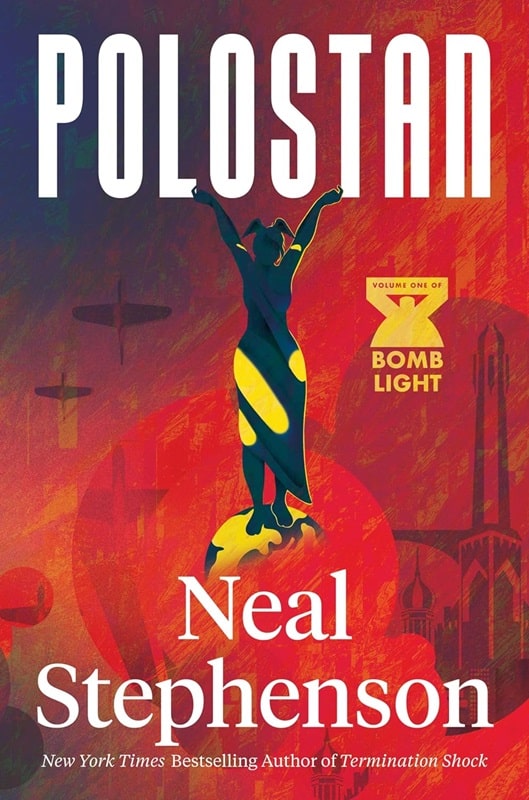
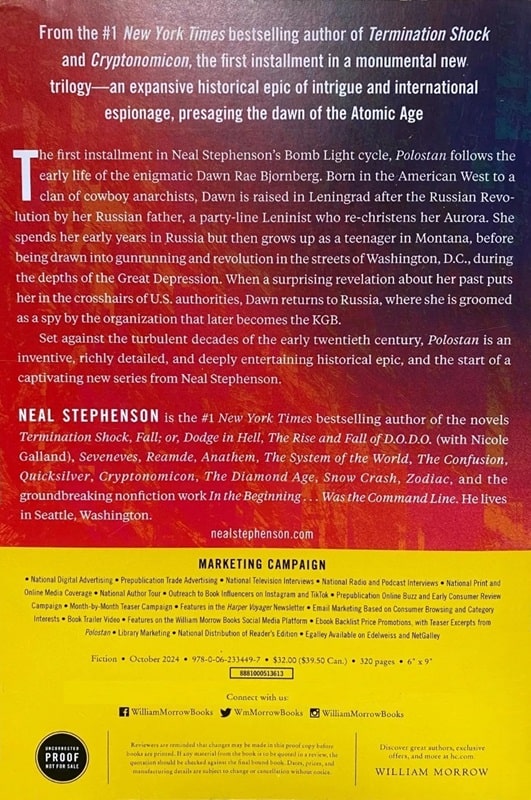
Polostan (William Morrow, October 15, 2024). Cover art uncredited
If, like me, you are a Neal Stephenson fan, you know he has a tendency to get deep into the descriptive weeds. I sometimes imagine his editor suggesting, “Neal, do we really need all this detail?” And then Neal grouchily responds, “If I didn’t think the story needed it, I wouldn’t have written it.”
Case in point from his latest novel, Polostan, a depiction of the 1933 Chicago World’s Fair Century of Progress exhibition where the protagonist, Dawn Rae Bjornberg, also known as Aurora Maximovna Artemyeva, works shilling for a shoe salesman:
She went to the fair early and stayed late, for the work was easy and there were plenty of diversions — that being the point of a fair. Her perambulations soon made her as conversant with the place as if it were an old city…As they were meant to, [the exhibits] drew visitors: 600 Norge salesmen on the B&O from Philly; 176 newsboys on the New York Central from Buffalo; 60 Episcopal bishops; 180 Civilian Conservation Corps workers en route to turpentine camps in the southeast; 100 Minnesota National Guard troops. Paramount Studios executives from Hollywood, Lions from St. Louis, Shriners from Fort Smith…
It goes on like this for quite a while. Do we really need to know that “Five hundred employees of the National Carbon Coated Paper Company of Sturgis, Michigan, arrived on the same train as 270 members of the Jewish Socialist Verband from New York City.” Probably not; it doesn’t further the plot, though it does provide a sort of Proustian vibe.
It’s also a metafictional joke Stephenson tells on himself. After Dawn/Aurora relates her life history to her Soviet inquisitor (which forms a kind of framework to a plethora of narratives, more about that in a second), he remarks, “You’ve been cooperative, if somewhat rambling. But that’s in the nature of your story — you really have been all over the place.”
“All over the place” is also how I’d describe this novel. But in a good way.
Born in 1916, a pivotal time in history when revolution was in the air, Dawn/Aurora’s childhood is split between Montana with her American radical mother and the Soviet Union with her Communist father (hence the American and Russian alter egos). Which makes her an ideal candidate for espionage against one of those countries. But which one is the question.
With an upbringing that includes acquiring equestrian skills, running guns and a fascination with Bonnie and Clyde as well as the Red Woman’s Death Battalion, the attention of then Major George Patton during an encampment of “Bonus Army” protesting World War I veterans in Washington, D.C., an abortion that makes her incapable of further pregnancy (and a matter-of-factly stated no-strings enticement to a prospective lover), and as a captive of con-artist evangelists as well as Soviet secret police OGPU led by the brutal Lavrentiy Beria. She is also witness to a deadly ballon ride by Soviet aeronauts named Elektron and Proton. We’ve already mentioned the Chicago World’s Fair.
But all of that is prologue and epilogue to Dawn’s chance meeting with “Dick,” a boy who impregnates her while on top of an early X-ray machine. Dick is probably Richard Feynman, who assisted in the development of the atomic bomb, but who here is a horny teenager happy to explain to Dawn current thinking in physics about possibly splitting the atom. Which makes her all the more a person of interest to Beria, who Stalin later appoints to head the Soviet atomic program. And which is why this is the first in a planned trilogy called Bomb Light.
Oh, and if you’re curious about what Polostan is supposed to mean, it is coined by British journalist Crisp-Upjohn, whom Aurora is tasked by the the OGPU to compromise, while playing against her during of an exhibition match with the Soviet women’s polo team.
So there is a lot here to unpack. But that Stephenson pulls off in a highly entertaining and brisk way. Because that is what Neal Stephenson does.
What there isn’t is a lot of is pages. While Stephenson is noted for producing doorstops, even for individual books in a series (The Baroque Cycle, for example, adds up to some 3,000 pages across three volumes), Polostan is a mere 303 pages. You might wonder why the author just didn’t produce one big book, other than that genre publishing suffers from a multi-volume series fixation. According to the author, the intent is to focus on a different character in each installment. “As far as the series format is concerned, we made a decision last year to bring it out one normal-sized book at a time, and to configure it in such a way that each volume will focus on one of the main characters. “
Also, Stephenson hasn’t finished writing it. So, there is that.
We wait with bated breath.
David Soyka is one of the founding bloggers at Black Gate. He’s written over 200 articles for us since 2008. His most recent was a review of Playground by Richard Powers.
Wizard of the Pigeons - Book Review
 Wizard of the Pigeonsby Megan Lindholm/Robin Hobb
Wizard of the Pigeonsby Megan Lindholm/Robin HobbWhat is it about:Seattle: a place as magical as the Emerald City. Subtle magic seeps through the cracks in the paving stones of the sprawling metropolis. But only the inhabitants who possess special gifts are open to the city's consciousness; finding portents in the graffiti, reading messages in the rubbish or listening to warnings in the skipping-rope chants of children.
Wizard is bound to Seattle and her magic. His gift is the Knowing -- a powerful enchantment allowing him to know the truth of things; to hear the life-stories of ancient mummies locked behind glass cabinets, to receive true fortunes from the carnival machines, to reveal to ordinary people the answers to their troubles and to safeguard the city's equilibrium. The magic has its price; Wizard must never have more than a dollar in his pocket, must remain celibate, and he must feed and protect the pigeons.
But a threat to Seattle has begun to emerge in the portents. A malevolent force born of Wizard's forgotten past has returned to prey upon his power and taunt him with images of his obscure history; and he is the only wizard in Seattle who can face the evil and save the city, his friends and himself.
What did I think of it:This is a reread. First time reading it has to be between 2001 and 2009 somewhere. I borrowed it and now finally have my own copy.
And even though I mainly remembered atmosphere and vibes, this is indeed as beautiful a read as I remember. The writing is beautiful and vivid, painting a clear picture of a Seattle full of magic. This is as much an ode to the whimsical history and hidden places of this city (which I hope are all real) as it is a powerful, emotional story about a man who when down on his luck discovers he's a wizard.
I loved Wizard, and I could understand him when things start getting dicey and he stumbles. I will say I had forgotten about one character he encounters, and how super annoying I found this character, but it all fits perfectly.
It was wonderful to revisit and rediscover this story, and you bet I will reread this again, especially now that I have this beautiful copy of it on my Keeper shelves.
Why should you read it:It's a beautifully written and emotional read.
Goth Chick News: Gushing Over Nosferatu
This is a true story.
Like most young people, the first couple of cars I drove were crap. However, I eventually got to the point in my career when I was able to purchase my first car for love. It was not only a gorgeous little black sports model with a stick shift, a rocking stereo system, and all the bells and whistles, but I also tagged it with my dream “vanity” license plate – NOS4AH2
Aside from indicating I had (and have) the taste in cars of a sixteen-year-old boy, and that my idea of what’s “cool” might be far closer to “geeky” than I care to think about, it shows I have had a long love of the original movie vampire.
When I first told you about Robert Egger’s film Nosferatu in July 2024, the first trailer had just dropped. Not much was known about it other than in the context of its historical 1922 predecessor which was a literal rip off of Dracula, and that Eggar’s movie was a remake.
Eggers’s journey to creating his adaptation of Nosferatu was a culmination of lifelong passion, meticulous research, and a series of professional developments. His fascination with the original 1922 film by F.W. Murnau began in his youth, inspiring him to adapt the story for the stage during high school. This early endeavor ignited his interest in filmmaking and set the foundation for his future projects. Over the years, he dedicated significant time to developing the script, ensuring a deep understanding of vampire lore and the historical context of the original film.
Eggers’s previous works, including The Witch (2015) and The Lighthouse (2019), showcased his talent for crafting atmospheric period pieces, further preparing him for the complex task of reimagining Count Orlok. By 2022, with a refined vision and increased industry clout, Eggers began work in earnest on Nosferatu. He assembled a cast including Bill Skarsgård as the Count, Lily-Rose Depp as Ellen, and Nicholas Hoult as Thomas Hutter.
Skarsgård getting his Orlok on
It was with Christmas giddiness that I went straight to the theater on December 25th to see Nosferatu at the first showing on its opening day. What I saw was cinematic gold worthy of the term “classic horror.” Instead of buckets of blood and cheap jump scares, Eggers served up an atmospheric story that built an ever-mounting dread. Using camera filters that blocked warm colors, the scenes he filmed give the feel of black and white darkness where long shadows hang. Eggers’s dedication to authenticity was evident in his meticulous attention to detail, from set designs inspired by 19th-century landscapes to sourcing period-specific materials for costumes.
Unlike the practical effects in the werewolf films I recently told you about, Egger used practical effects successfully and to the extreme. Word on the Hollywood grapevine is that 5000 live rats were employed to run through the sets and crawl on the actors. While the exact number of actual wolves employed has not been publicly specified, there were at least a dozen. Hoult recounted a particularly intense scene where his character, Thomas Hutter, is pursued by these wolves. He described the experience noting that the wolves were held back on leashes, barking with “death in their eyes.” During one take, Hoult slipped and narrowly escaped through a window as the wolves were released after him.
Though Willem Dafoe as the VanHelsing character, Prof. Albin Eberhart von Franz caught some critic shrapnel for playing himself more than the character, I thought the performances were incredible. Lily-Rose Depp had me mesmerized, one minute the innocent young wife and the next a wonton, demon-possessed bride of the vampire. She made me wonder if dear old dad is proud, or dying of envy.
Skarsgård as Count Orlok however, really brought the magic. Having lost a significant amount of weight and, refusing to have his voice digitally modulated, Skarsgård worked with the Icelandic opera singer Ásgerður Júníusdóttir to lower his vocal range, incorporating Mongolian throat singing into his lines. He also spent up to six hours a day having prosthetic makeup applied to embody a vampiric vision that was truly unique to this film. Skarsgård likened his experience to “conjuring pure evil,” which I truly felt every time he took the screen.
Yes, Eggars really used live rats…
As of last weekend, Nosferatu has made $167M against a $50M production budget, making it a box office success by Hollywood terms. The film is also streaming now, while still appearing in theaters and as of January 24th, a “director’s cut” is available. You know I snagged that and the best thing about it is more screen time for Skarsgård.
Nosferatu has also been nominated for four Oscars: Best Cinematography, Best Make-Up & Hair, Best Costume Design, Best Production Design. I think it will take at least two of these.
So, after a long dry spell I have the opportunity to actually gush over a horror movie and Nosferatu will go down as one of my personal favs.
Spotlight on “At Dark, I Become Loathsome” by Eric LaRocca
From Eric LaRocca comes At Dark, I Become Loathsome, a grim yet gentle, horrifying yet…
The post Spotlight on “At Dark, I Become Loathsome” by Eric LaRocca appeared first on LitStack.
On McPig's wishlist - Night's Master
 Night's Master (Flat Earth #1)by Tanith LeeA DARK FANTASY CLASSIC: 18 seductive stories inspired by fairy tales, mythology, and the Arabian Nights, starring Azhrarn, Prince of Demons.
Night's Master (Flat Earth #1)by Tanith LeeA DARK FANTASY CLASSIC: 18 seductive stories inspired by fairy tales, mythology, and the Arabian Nights, starring Azhrarn, Prince of Demons.“Storytelling at its best and fantasy in its purest and strongest essence”—(SFSite)!
Rediscover master fantasist and World Fantasy Award winner Tanith Lee’s classic dark fantasy series, Tales from the Flat Earth, where demons and gods grant wonders and wreak havoc. Visit the Upperearth, where dwell the gods; the Underearth, the realm of nightmarish demons; the Innerearth, domain of the dead; and the Flat Earth itself, the home of mortals.
Supreme amongst them all is the demon god Azhrarn, Night’s Master, whose deadly whims could change the lives of those in the Flat Earth. Azhrarn holds in his heart a mystery which could alter the very existence of the Flat Earth forever.
Nominated for the World Fantasy Award for Best Novel, the first Flat Earth epic fantasy introduces a fascinating world reminiscent of the Arabian Nights.


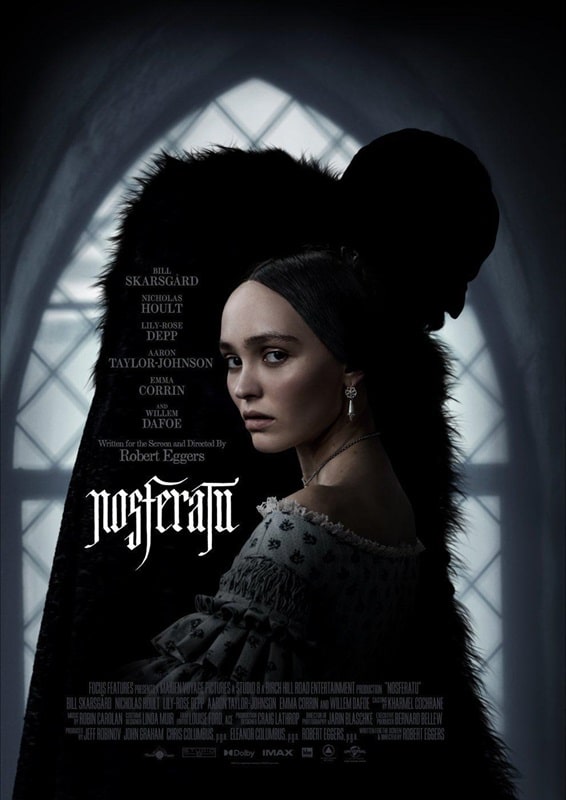
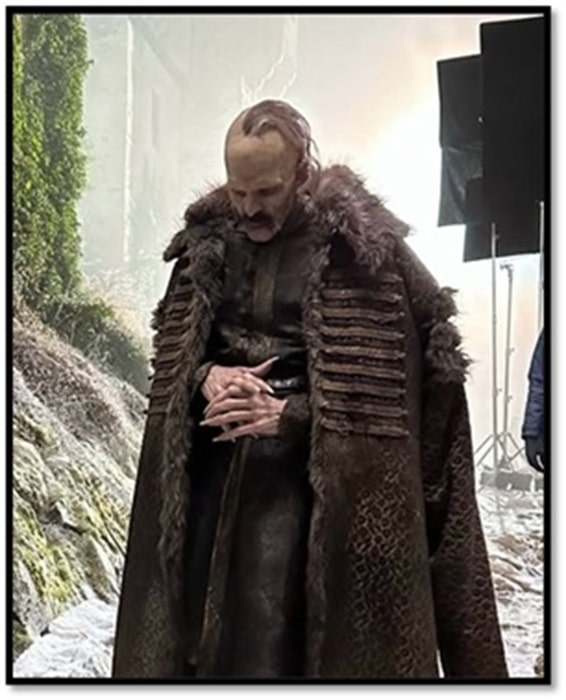


Recent comments